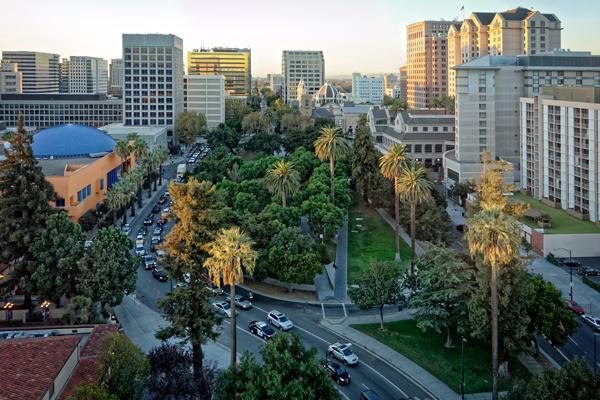Cities across the world are investing in Advanced Metering Infrastructure (AMI) to better serve growing populations. AMI improves efficiency and helps conserve water by providing timely information customers can use to adjust their usage. San Jose Water (SJW) is currently in the process of implementing AMI to help conserve water during the California drought in the San Jose area.
New Technology: Advanced Metering Infrastructure
In water systems with traditional water meters, utility employees typically visit each meter once every month or two to obtain readings. (SJW staff read meters bimonthly.) The downside of this method is that water leaks may not be noticed until the next time the meter reader comes by.
In contrast, Automatic Meter Readers (AMRs) provide water usage data automatically to the utility on an hourly basis. A small number of SJW customers (mainly large industrial operations or those located in remote areas) have AMRs. Although AMRs are automated, the flow of information is one way from the customer’s location to the utility.
Advanced Metering Infrastructure is the latest advance in metering technology. These systems include automatic meters that take hourly readings every day and a data transmission system to provide this water usage data to both customers and utility staff in real time. These systems provide for two-way communication, allowing the utility to contact the customer in a timely way regarding excessive water use.
How does Advanced Metering Infrastructure share water usage data with the utility?
Advanced Metering Infrastructure water meters are an advanced type of AMR capable of sending water use data over a communications network. The type of communications network used may include broadband, radio frequency or public landline or cell phone. Water usage data is received by a Meter Data Management (MDM) system, which is hosted in a cloud-based system. The MDM stores and analyzes the data before providing it to the utility in a useful form.
How does the Advanced Metering Infrastructure share water usage data with the customer?
AMI water meters can share data with the customer as well as the utility. Customers can have 24/7 access to their water use information using the web or a smartphone app. Customers can also choose to receive text or email alerts about leaks or unusual usage. In addition, the utility can send specific messages to the customer’s AMI meter. If necessary, the utility can also send a command to the AMI to disconnect service remotely, like when a customer moves from a property.
Why use Advanced Metering Infrastructure?
AMI has a number of advantages over traditional or even AMR methods. The major advantage of implementing AMI is to reduce wasted water. With AMI, water usage is checked far more frequently, which means that leaks can be found and fixed early, rather than waiting until a large bill arrives to start investigating. In addition, because customers will have a much more accurate picture of their water usage, they will be able to adjust their usage as needed or desired.
Another advantage of AMI is that the utility can monitor water usage remotely without the expense of sending meter readers into the field. In fact, this and other savings from implementing AMI may be sufficient to completely cover the costs of investing in the new technology.
Finally, AMI is expected to improve communication between customers and billing representatives because they will have access to the same real-time data when discussing water bills.
What is the status of SJW’s progress toward full use of Advanced Metering Infrastructure?
An AMI pilot program in the Willow Glen area of San Jose has been approved by the California Public Utilities Commission (CPUC). This program will compare water usage pre- and post-AMI implementation for about 400 customers in each of two adjacent meter-reading routes. One of the routes will test a fixed-network AMI system, while the other will test a cellular-based AMI system. Customer water usage on these two routes will be compared to that of an adjacent neighborhood without updated meters or AMI. Pilot program results will be collected through mid-2017, then CPUC will evaluate the results and determine whether full deployment of AMI technology is appropriate for SJW.
For more information on advanced metering infrastructure and how SJW is employing it to help conserve water in the San Jose area, please follow us on Twitter.
